YouTube wants to sell more video ads, but first remove them from the video
Click on the blue font above to follow.
You can also search for public numbers"D1net"Choose to focus on the sub-public numbers of D1net's various areas (cloud computing, data centers, big data, CIOs, enterprise collaboration, network numbering, information security, enterprise mobile applications, system integration, servers, storage, call centers, video conferencing, video surveillance, etc.).
=======

YouTube, the world's largest shared video site, has plans to generate more advertising revenue by removing ads from videos. YouTube has explained the benefits of this "de-monetizing" video, but video creators are clearly freaking out.
YouTube hopes to make its stock videos more appealing to advertisers by priority-labeling videos that contain "non-ad-friendly content." In YouTube's words, it's about "monecuring" videos.
YouTube says it has been implementing a similar policy for some time. But this week, the practice became more controversial, largely because YouTube star Philip DeFranco found that several of his videos couldn't run ads. "YouTube is shutting down my channel and it looks like they're trying to isolate me, " says Mr de Frank. "
In response, a YouTube spokesman said YouTube was doing a better job of telling YouTube creators that their videos no longer ran ads and that they could appeal and re-install them. YouTube said: "Our de-monificization video policy has not changed our relationship with advertisers and we have recently improved our notification and appeal procedures to ensure better communication with creators. "
YouTube also says only 1% of "partner videos" have been "de-moneified", such as those sold by De Frank. From YouTube's point of view, such a policy makes sense, in part because advertisers have long worried that when they buy YouTube ads, they don't know what they're buying.
But like many technology companies, YouTube is secretive about its tagging process and how to identify "non-ad-friendly content." YouTube has said that "non-ad-friendly content" includes "sexual humor," "controversial or sensitive topics." But because YouTube is so interested in selling ads, it may want to find better ways to communicate with people who create a lot of content.
It's worth noting that YouTube is facing increasing competition from video views and video creators. Twitter has just announced that it will start sharing ad revenue with content creators and will provide them with a better way to share revenue than YouTube. Facebook hasn't launched a YouTube-like revenue-sharing program yet, but it's certainly working on it. The same is true of Snapchat.
(Source: Tencent Technology)
Go to "Discovery" - "Take a look" browse "Friends are watching"